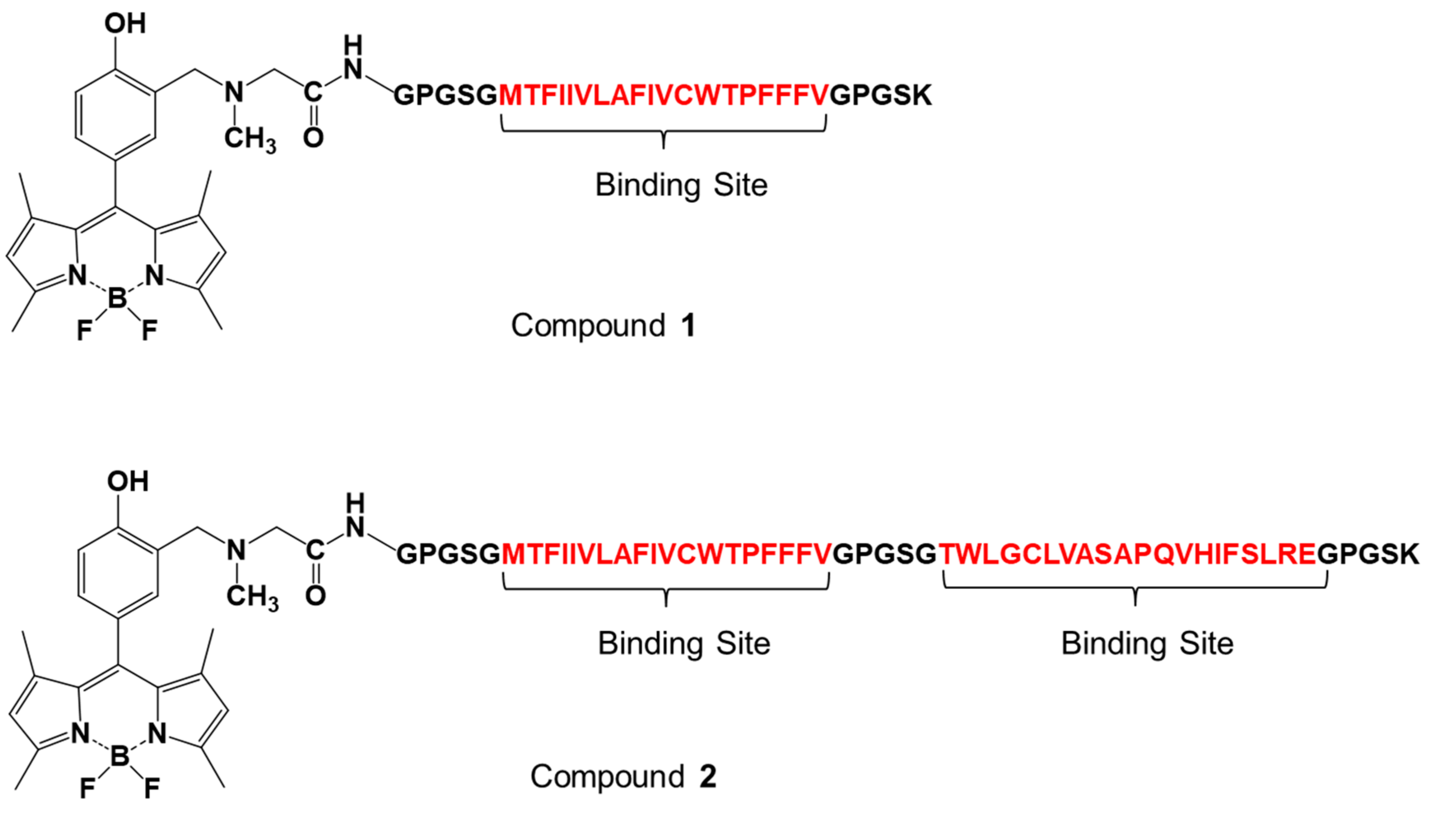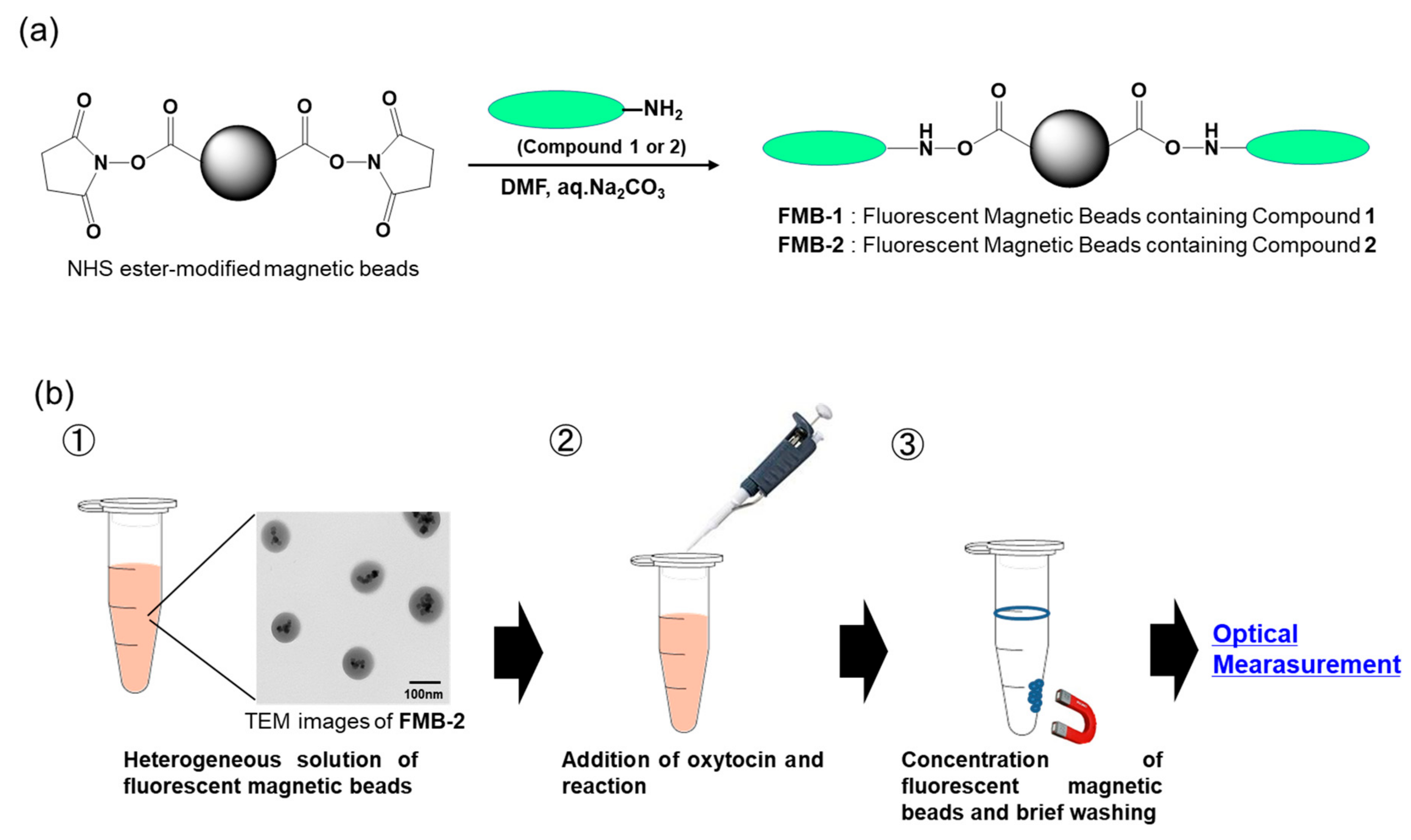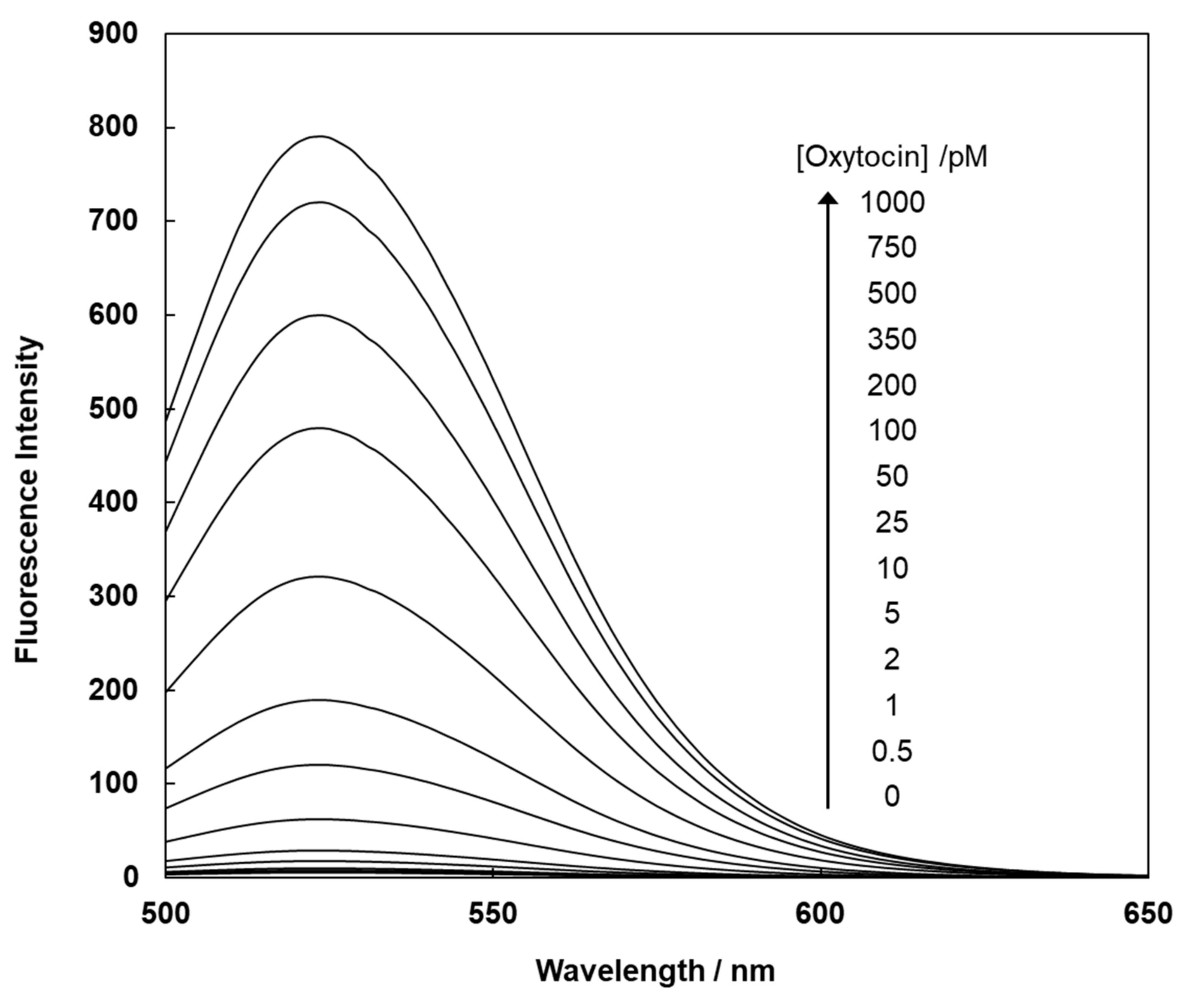Development of Magnetic Nanobeads Modified by Artificial Fluorescent Peptides for the Highly Sensitive and Selective Analysis of Oxytocin
Abstract
:1. Introduction
2. Materials and Methods
2.1. Chemicals and Reagents
2.2. Synthesis of Fluorescent Peptides for the Detection of Oxytocin
2.3. Synthesis of Fluorescent Magnetic Beads (FMB-1 and FMB-2)
2.4. Performance Evaluation of Fluorescent Magnetic Beads in Oxytocin Level Measurement
3. Results and Discussion
4. Conclusions
Supplementary Materials
Funding
Conflicts of Interest
References
- Carter, C.S. Developmental consequences of oxytocin. Physiol. Behav. 2003, 79, 383–397. [Google Scholar] [CrossRef]
- Engle, M.P.; Ness, T.J.; Robbins, M.T. Intrathecal oxytocin inhibits visceromotor reflex and spinal neuronal responses to noxious distention of the rat urinary bladder. Reg. Anesth. Pain Med. 2012, 37, 515–520. [Google Scholar] [CrossRef] [PubMed]
- Gutierrez, S.; Liu, B.; Hayashida, K.; Timothy, T.H.; James, C.E. Reversal of peripheral nerve injury-induced hypersensitivity in the postpartum period role of spinal oxytocin. Anesthesiology 2013, 118, 152–159. [Google Scholar] [CrossRef] [PubMed] [Green Version]
- Leong, K.C.; Cox, S.; King, C.; Becker, H.; Reichel, C.M. Oxytocin and rodent models of addiction. Int. Rev. Neurobiol. 2018, 140, 201–247. [Google Scholar] [PubMed]
- Smith, S.; Tabbaa, M.; Lei, K.; Eastham, P.; Butler, M.J.; Linton, L.; Wang, Z. Local oxytocin tempers anxiety by activating GABAA receptors in the hypothalamic paraventricular nucleus. Psychoneuroendocrinology 2016, 63, 50–58. [Google Scholar] [CrossRef] [PubMed] [Green Version]
- Ferrer-Pérez, C.; Castro-Zavala, A.; Luján, M.Á.; Filarowska, J.; Ballestín, R.; Miñarro, J.; Rodríguez-Arias, M. Oxytocin prevents the increase of cocaine-re-lated responses produced by social defeat. Neuropharmacology 2019, 146, 50–64. [Google Scholar] [CrossRef]
- Bowen, M.T.; Neumann, I.D. The Multidimensional Therapeutic Potential of Targeting the Brain Oxytocin System for the Treatment of Substance Use Disorders. In Behavioral Pharmacology of Neuropeptides: Oxytocin; Springer: Cham, Switzerland, 2017; pp. 269–287. [Google Scholar]
- Menon, R.; Grund, T.; Zoicas, I.; Althammer, F.; Fiedler, D.; Biermeier, V.; Grinevich, V. Oxytocin signaling in the lateral septum prevents social fear during lactation. Curr. Biol. 2018, 28, 1066–1078. [Google Scholar] [CrossRef] [Green Version]
- Higashida, H.; Lopatina, O.; Yoshihara, T.; Pichugina, Y.A.; Soumarokov, A.A.; Munesue, T.; Minabe, Y.; Kikuchi, M.; Ono, Y.; Korshunova, N.; et al. Oxytocin signal and social behaviour: Comparison among adult and infant oxytocin, oxytocin receptor and CD38 gene knockout mice. J. Neuroendocrinol. 2010, 22, 373–379. [Google Scholar] [CrossRef]
- Ho, J.M.; Blevins, J.E. Coming full circle: Contributions of central and peripheral oxytocin actions to energy balance. Endocrinology 2013, 154, 589–596. [Google Scholar] [CrossRef] [Green Version]
- Ferrer-Pérez, C.; Reguilón, M.D.; Manzanedo, C.; Miñarro, J.; Rodríguez-Arias, M. Rodríguez-Arias, Social housing conditions modulate the long-term increase in cocaine reward induced by intermittent social defeat. Front. Behav. Neurosci. 2019, 13, 148. [Google Scholar] [CrossRef] [Green Version]
- Xu, S.; Qin, B.; Shi, A.; Zhao, J.; Guo, X.; Dong, L. Oxytocin inhibited stress induced visceral hypersensitivity, enteric glial cells activation, and release of proin-flammatory cytokines in maternal separated rats. Eur. J. Pharmacol. 2018, 818, 578–584. [Google Scholar] [CrossRef]
- Robinson, J.K.; Hazon, N.; Lonergan, M.; Patrick, P.P. Validation of an enzyme-linked immunoassay (ELISA) for plasma oxytocin in a novel mammal species reveals potential errors induced by sampling procedure. J. Neurosci. Meth. 2014, 226, 73–79. [Google Scholar] [CrossRef]
- Washio, H.; Takeshita, D.; Sakata, S. Parasympathetic nervous activity is associated with oxytocin in multiparous, but not primiparous, women during the perinatal period. Clin. Exp. Pharm. Physiol. 2020, 47, 955–965. [Google Scholar] [CrossRef] [PubMed]
- Franke, A.A.; Li, X.N.; Menden, A.; Lee, M.R.; Lai, J.F. Oxytocin analysis from human serum, urine, and saliva by orbitrap liquid chromatography-mass spectrometry. Drug Test. Anal. 2019, 11, 119–128. [Google Scholar] [CrossRef] [PubMed] [Green Version]
- Yue, X.L.; Lu, L.P.; Liu, H.S.; Xue, H.Z. Pharmacokinetics, bioavailability and metabolism of cligosiban, an antagonist of oxytocin receptor, in rat by liquid chromatography hyphenated with electrospray ionization tandem mass spectrometry. J. Pharm. Biomed. Anal. 2019, 164, 725–733. [Google Scholar] [CrossRef] [PubMed]
- Nag, O.K.; Muroski, M.E.; Hastman, D.A.; Almeida, B.; Medintz, I.L.; Huston, A.L.; Delehanty, J.B. Nanoparticle-Mediated Visualization and Control of Cellular Membrane Potential: Strategies, Progress, and Remaining Issues. ACS Nano 2020, 14, 2659–2677. [Google Scholar] [CrossRef]
- Wu, F.; Ye, J.H.; Cao, Y.L.; Wang, Z.Y.; Miao, T.T.; Shi, Q. Recent advances in fluorescence sensors based on DNA-MOF hybrids. Luminescence 2020, 35, 440–446. [Google Scholar] [CrossRef]
- Liu, M.; Kan, J.L.; Yao, Y.Q.; Zhang, Y.Q.; Bian, B.; Tao, Z.; Zhu, Q.J.; Xiao, X. Facile preparation and application of luminescent cucurbit[10]uril-based porous supramolecular frameworks. Sens. Actutors Chem. 2019, 283, 290–297. [Google Scholar] [CrossRef]
- Pallavi, P.; Kumar, V.; Hussain, W.; Patra, A. Excited-State Intramolecular Proton Transfer-Based Multifunctional Solid-State Emitter: A Fluorescent Platform with “Write-Erase-Write” Function. ACS Appl. Mater. Interfaces 2018, 10, 44696–44705. [Google Scholar] [CrossRef]
- Kolpashchikov, D.M. Binary probes for nucleic acid analysis. Chem. Rev. 2010, 110, 4709–4723. [Google Scholar] [CrossRef]
- Wallace, D.J.; Borgloh, M.Z.A.; Astori, S.; Yang, Y.; Bausen, M.; Kugler, S.; Palmer, A.E.; Tsien, R.Y.; Sprengel, R.; Kerr, J.N.; et al. Single-spike detection in vitro and in vivo with a genetic Ca2+ sensor. Nat. Methods 2008, 5, 797–804. [Google Scholar] [CrossRef] [PubMed]
- Suzuki, Y.; Yokoyama, K. Design and synthesis of intramolecular charge transfer-based fluorescent reagents for the highly sensitive detection of proteins. J. Am. Chem. Soc. 2005, 127, 17799–17802. [Google Scholar] [CrossRef] [PubMed]
- Wu, H.; Chen, M.N.; Xu, Q.Q.; Zhang, Y.; Liu, P.P.; Li, W.Y.; Fan, S.H. Switching to a “turn-on” fluorescent probe for selective monitoring of cyanide in food samples and living systems. Chem. Commun. 2019, 55, 15137–15140. [Google Scholar] [CrossRef]
- Chen, S.; Xue, Z.X.; Gao, N.; Yang, X.M.; Zang, L. Perylene Diimide-Based Fluorescent and Colorimetric Sensors for Environmental Detection. Sensors 2020, 20, 917. [Google Scholar] [CrossRef] [PubMed] [Green Version]
- Ahmed, M.; Faisal, M.; Ihsan, A.; Naseer, M.M. Fluorescent organic nanoparticles (FONs) as convenient probes for metal ion detection in aqueous medium. Analyst 2019, 144, 2480–2497. [Google Scholar] [CrossRef]
- Ali, A.A.; Kharbash, R.; Kim, Y. Chemo- and biosensing applications of spiropyran and its derivatives A review. Anal. Chim. Acta 2020, 1110, 199–223. [Google Scholar] [CrossRef] [PubMed]
- Suzuki, Y. Development of a Fluorescent Peptide for the Highly Sensitive and Selective Detection of Oxytocin. Sens. Actutors B Chem. 2018, 254, 321–328. [Google Scholar] [CrossRef]
- Ziessel, R.; Ulrich, G.; Harriman, A. The chemistry of Bodipy: A new El Dorado for fluorescence tools. New J. Chem. 2007, 31, 496–501. [Google Scholar] [CrossRef]
- Ulrich, G.; Ziessel, R.; Harriman, A. The chemistry of fluorescent Bodipy dyes: Versatility unsurpassed. Angew. Chem. Int. Ed. 2008, 47, 1184–1196. [Google Scholar] [CrossRef]
- Kimura, T.; Tanizawa, O.; Mori, K.; Brownstein, M.J.; Okayama, H. Structure and expression of a human oxytocin receptor. Nature 1992, 356, 526–529. [Google Scholar] [CrossRef]
- Suzuki, Y. Development of Fluorescent Reagent Based on Ligand Exchange Reaction for Highly Sensitive and Selective Detection of Dopamine in the Serum. Sensors 2019, 19, 3928. [Google Scholar] [CrossRef] [Green Version]
- Bendahan, C.C.; Beijers, R.; van Doornen, L.J.P.; de Weerth, C. Explicit and Implicit Caregiving Interests in Expectant Fathers: Do Endogenous and Exogenous Oxytocin and Vasopressin Matter? Infant Behav. 2015, 41, 26–37. [Google Scholar] [CrossRef] [PubMed]




| Added Oxytocin (pM) | Expected (pM) | Measured (pM) a | CV (%) b | Recovery (%) c |
|---|---|---|---|---|
| 10.00 | 10.00 | 10.09 | 2.7 | 100.9 |
Publisher’s Note: MDPI stays neutral with regard to jurisdictional claims in published maps and institutional affiliations. |
© 2020 by the author. Licensee MDPI, Basel, Switzerland. This article is an open access article distributed under the terms and conditions of the Creative Commons Attribution (CC BY) license (http://creativecommons.org/licenses/by/4.0/).
Share and Cite
Suzuki, Y. Development of Magnetic Nanobeads Modified by Artificial Fluorescent Peptides for the Highly Sensitive and Selective Analysis of Oxytocin. Sensors 2020, 20, 5956. https://doi.org/10.3390/s20205956
Suzuki Y. Development of Magnetic Nanobeads Modified by Artificial Fluorescent Peptides for the Highly Sensitive and Selective Analysis of Oxytocin. Sensors. 2020; 20(20):5956. https://doi.org/10.3390/s20205956
Chicago/Turabian StyleSuzuki, Yoshio. 2020. "Development of Magnetic Nanobeads Modified by Artificial Fluorescent Peptides for the Highly Sensitive and Selective Analysis of Oxytocin" Sensors 20, no. 20: 5956. https://doi.org/10.3390/s20205956




